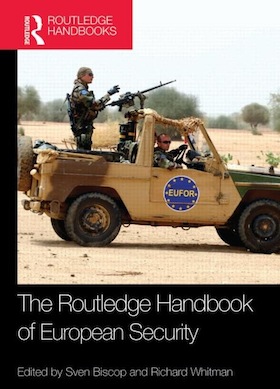European Integration is a field with an immense range of teaching texts available. This does not simply apply to catch-all textbooks, but also to an increasing range of student-facing texts dedicated to sub-areas of EU studies. The two books in this feature each fall into one of the aforementioned categories. The Oxford Handbook of the European Union seeks to compete with the plethora of EU textbooks and readers on the market, whilst the Routledge Handbook of European Security aims at its own niche market of EU-security and foreign policy studies.
 The Oxford Handbook of the European Union is instantly impressive in one respect; breadth. Being intricately familiar with most EU books on the market as I have taught European Integration in one respect or another for nearly four years, it is always clear to see where each editor/author has made decisions over what to leave out of their respective textbook – or at the very least to identify those themes they would like to prioritise over others. However, here, there seems to have been made a genuine effort to avoid a ‘textbook’ approach and instead produce a book that can be referred to in a semi-encyclopaedic fashion when a student needs some targeted information on any aspect of EU studies.
The Oxford Handbook of the European Union is instantly impressive in one respect; breadth. Being intricately familiar with most EU books on the market as I have taught European Integration in one respect or another for nearly four years, it is always clear to see where each editor/author has made decisions over what to leave out of their respective textbook – or at the very least to identify those themes they would like to prioritise over others. However, here, there seems to have been made a genuine effort to avoid a ‘textbook’ approach and instead produce a book that can be referred to in a semi-encyclopaedic fashion when a student needs some targeted information on any aspect of EU studies.
The chapters are concise, well written and generally accessible – authored by a roster of notable EU experts. The editorial decision to section the handbook up into ten ‘parts’ is an immediate point of focus. The coherence of the ‘parts’ does not meet what would be expected of, say, a textbook. There is a very ‘stand-alone’ feel to each chapter. As an example, ‘part two,’ which contains seven chapters on EU treaties, does not contain a section situating why EU treaties are important – nor does it have a section putting them in perspective. Such editorial prefaces/conclusions would have benefited the reader – and they may ultimately lead to readers/instructors preferring to stick with more conventional textbooks.
Yet, despite this criticism it is refreshing to find a book with a dedicated, and substantial, chapter on each of the EU treaties – which the competitor textbooks generally do not have. These chapters will serve as a solid starting point for any assignment involving treaties, and also served me well in aiding my design of several lectures due to the concise and well-edited flow of the chapters.
In sum, the observations noted above regarding the stand-alone nature of the ‘parts’ and chapters apply to the entire Handbook. It makes best reading in compliment to a more standard textbook, which will help students link up the basics in a more friendly way. It should not be the first/only general text you buy/read on the EU. At the same time, for more advanced students of the EU, the Handbook is an excellent, and accessible, reference tool that makes for a solid investment.
The Routledge Handbook of European Security  comes with a cover that immediately informs the reader that the EU is now a security actor. 25 years ago the thought that there would be military vehicles with EUFOR (the acronym of the EU’s Rapid Reaction Force) printed on the side, complete with troops deployed under an EU-mandated military operation, was futuristic at best. Yet, the EU is now an active international security actor and has conducted operations in multiple countries outside its borders. This has fuelled a burgeoning academic literature.
comes with a cover that immediately informs the reader that the EU is now a security actor. 25 years ago the thought that there would be military vehicles with EUFOR (the acronym of the EU’s Rapid Reaction Force) printed on the side, complete with troops deployed under an EU-mandated military operation, was futuristic at best. Yet, the EU is now an active international security actor and has conducted operations in multiple countries outside its borders. This has fuelled a burgeoning academic literature.
As a Handbook, much like the Oxford Handbook above, this book is split into parts that contain individual chapters – each written by an expert on that area. The difference is that the chapters in the Routledge Handbook generally avoid the ‘stand-alone’ feel of the Oxford Handbook.
For example, Part One contains five chapters on the EU’s development as a security actor. This ‘part’ immediately brings the reader up to speed on the larger transition/development in effect in EU security capabilities. More importantly the part is bookended with chapters that provide linkage and important context. The first chapter (by Jolyon Howorth) sets out a wide ranging – and critical – introduction to the institutional development of EU security. Complimenting this, the fifth chapter (by Christoph Meyer) deals with ‘taking stock and looking ahead’. And it does exactly what it says on the tin. The editorial decision to shape the parts this way is rewarding for the reader – and successful. It brings a sense of flow to the Handbook. Other parts of the book continue this formula.
For any student of EU security, this is a solid text. The chapters cover the wider themes of institutions, policies, partners, and theoretical frameworks – and simultaneously apply those to particular cases such as (for example) the EU’s Iran and Sub-Saharan policies. All that is missing in the Handbook is a more substantial introduction section.
When both of these Handbooks are released in paperback, they will be strong options for students of EU studies.